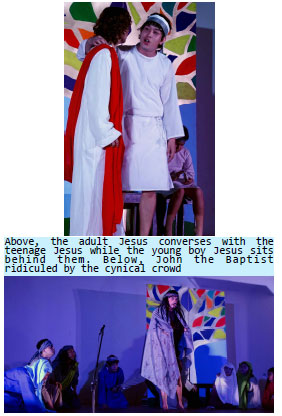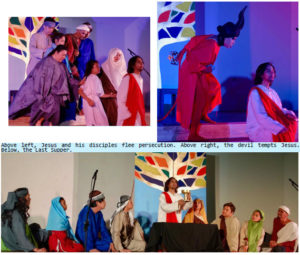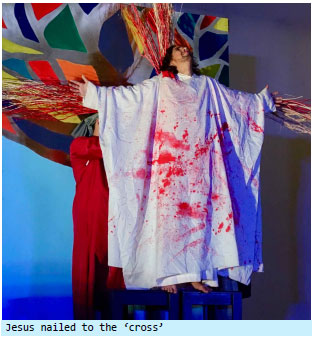Nestor Torre’s ‘Kordero ng Diyos’ Staged at CTK Social Hall
More than 10 years ago, Nestor Torre, well-known critic, Inquirer columnist, and playwright-director, was moved by the theme of Jesus Christ sacrificing his life for the salvation of mankind. He saw that Jesus’ divine nature would understand and accept the need to sacrifice himself. But, what about his human nature? Would it be so readily, heroically accepting?
Around this dilemma, Mr. Torre conceived the 85-minute play, ‘Kordero ng Diyos’, centered around Christ’s agony in the garden of Gethsemane. The play was staged last Friday, April 7 at the CTK Social Hall of the CTK Formation Center.
 To allow Christ to cope with the question of why God, his father, would allow him to suffer and die for the world’s sinners, director Torre made liberal use of flashbacks and conversations of the adult Jesus with the young boy Jesus and the teenage Jesus.
To allow Christ to cope with the question of why God, his father, would allow him to suffer and die for the world’s sinners, director Torre made liberal use of flashbacks and conversations of the adult Jesus with the young boy Jesus and the teenage Jesus.
The episodes with the young boy Jesus allows the adult Jesus to teach him the virtue of patience and acceptance as it related to the wounded bird that had to heal before it could once again take flight. It therefore dawns on the adult Jesus that he himself had to accept that the coming suffering was part of the Father’s plan. With the teenage Jesus who admits a bit of ignorance to God’s plan, the adult Jesus learns that not everything is easily comprehensible.
Nestor Torre also brings in Job, the good and prosperous family man who is beset with horrendous disasters that take away all that he holds dear, including his offspring, his health, and his property. As Job struggles to understand his situation and begins a search for the answers to his difficulties, Jesus begins to understand that his situation is Job-like. The other episode involves Abraham, whom God asks to sacrifice his only son Isaac. Abraham stood ready to follow God’s command but is stopped by the angel at the last second, having proved his devotion and steadfastness. In there is a similar lesson for the adult Jesus.
 By play’s end, Jesus has gone through the stages of denial, anger, confusion, resignation, and finally calm acceptance and understanding of the Father’s plan as he hangs nailed to the cross.
By play’s end, Jesus has gone through the stages of denial, anger, confusion, resignation, and finally calm acceptance and understanding of the Father’s plan as he hangs nailed to the cross.
The play used less than a dozen actors, with several playing several parts at different times. All were obviously professional stage actors with good presence, acting voice, and timing. The audience was particularly appreciative of the girl playing Mary, the angel, and one of the faces in the crowd. Ditto with the girl who played the devil, who was shorn of her horns and tail by God in a comic twist as they bet on whether Job would desert God or not after all his miseries.
Interestingly, there was the barest of props, simply a wall painted with a multi-color tree and two benches in front of it. The wall also served as an exit as well as changing room.
 Sure, there were the scenes you would expect – the last supper, the betrayal by Judas, the implied torture by the Roman centurions, the finding of Jesus preaching at the temple, the sermon on the mount, the miracles, John the Baptist, the pharisees’ umbrage, Peter’s loyalty, etc. But these were secondary to Jesus’ agony – clearly, it was a different but well-appreciated twist on the Lenten story.
Sure, there were the scenes you would expect – the last supper, the betrayal by Judas, the implied torture by the Roman centurions, the finding of Jesus preaching at the temple, the sermon on the mount, the miracles, John the Baptist, the pharisees’ umbrage, Peter’s loyalty, etc. But these were secondary to Jesus’ agony – clearly, it was a different but well-appreciated twist on the Lenten story.
